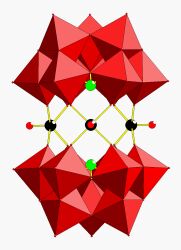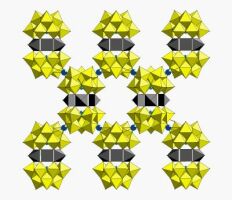|
Beteiligte Wissenschaftler: Dr. Daniel Drewes, Prof. Dr. Bernt Krebs
Chemie der Polyoxometallate
Unter Polyoxometallaten versteht man im allgemeinen Metall-Sauerstoff-Cluster,
die vorwiegend von den Elementen Molybdän und Wolfram in ihren
höchsten Oxidationsstufen gebildet werden. In allen Polyoxometallaten
sind die Metallatome durch Sauerstoffatome verbrückt. Polyoxometallate
bzw. Polyoxoanionen werden in zwei Gruppen klassifiziert: Isopolyanionen
bestehen nur aus einem metallischen Element sowie Sauerstoff, in
Heteropolyanionen hingegen liegen ein oder mehrere weitere Elemente
vor. Über 70 Elemente aus allen Gruppen des Periodensystems
- mit Ausnahme der Edelgase - sind mittlerweile als Heteroatome
in Polyoxometallaten bekannt.
1933 konnte Keggin erstmals anhand von Röntgenpulveraufnahmen
des H3[PW12O40] die Struktur eines Polyoxometallates aufklären.
Heteropolyanionen dieses Strukturtyps werden heute allgemein als
Keggin-Anionen bezeichnet. Ein wesentlicher Teil der Forschung an
Polyoxometallaten beschäftigt sich mit der Keggin-Struktur
und ihren Defektstrukturen; zahlreiche Heteropolyanionen enthalten
Fragmente des Keggin-Anions. Die Defektstrukturen der Keggin-Anionen
können mit vielen Metallen Cluster unterschiedlicher Größe
bilden. Die meisten der bekannten Strukturen enthalten etwa zwanzig
Polyatome, es konnten aber auch Cluster mit zum Teil über 100
Polyatomen dargestellt werden. Die Darstellung übergangsmetallsubstituierter
Polyoxoanionen stellt einen wichtigen Arbeitsschwerpunkte der Polyoxometallat-Gruppe
dar. Die Abbildung zeigt ein [(M(H2O))3(XW9O33)2]n- - Anion, das
zwei (XW9O33)m- - Keggin - Defektfragmente enthält.

In den letzten Jahren erlangte die Verbindungsklasse der Polyoxometallate
zunehmende Bedeutung im Bereich der Oxidations- und Säurekatalyse.
Zahlreiche Heteropolyverbindungen werden bereits erfolgreich als
effektive Katalysatoren in unterschiedlichsten Industrieprozessen
eingesetzt. Zu den am intensivsten untersuchten katalytischen Prozessen
zählt die Epoxidierung von Alkenen mit Wasserstoffperoxid als
Sauerstoffdonor. Dabei kann festgestellt werden, daß vor allem
die Katalysatorstruktur sowie die Art und Anzahl der substituierten
Übergangsmetalle einen großen Einfluß auf die katalytische
Aktivität ausüben können. Die in unserer Arbeitsgruppe
synthetisierten Polyoxowolframate haben sich als effektive Katalysatoren
erwiesen. Über die ablaufenden Katalysemechanismen bestehen
jedoch nach wie vor große Unklarheiten. Deshalb ist die Synthese
und Strukturaufklärung neuartiger Polyoxometallate sowie deren
anwendungsbezogene Untersuchung und der Vergleich mit bisherigen
Ergebnissen von großer Bedeutung.

Abbildung: Über Kaliumionen verbrückte Schicht aus [(VO)3(AsW9O33)]12-
- Anionen
 Seitenanfang Seitenanfang
Kooperationspartner
Prof. Dr. Dirk Volkmer, Universität Ulm ( vormals Universität Bielefeld) vormals Universität Bielefeld)
 Dr. Dirk G. Kurth, Max-Planck-Institut für Kolloid- und Grenzflächenforschung Dr. Dirk G. Kurth, Max-Planck-Institut für Kolloid- und Grenzflächenforschung
 Priv.-Doz. Dr. Dirk Andrae, Universität Bielefeld Priv.-Doz. Dr. Dirk Andrae, Universität Bielefeld
 Seitenanfang Seitenanfang
Veröffentlichungen
- D. Drewes, B. Krebs
"Lanthanoidhaltige Komplexe monovakanter Keggin- und Dawson-Polyoxoanionen"
Z. Naturforsch. 2006, angenommen.
- D. Drewes, B. Krebs
"Synthesis and Structure of a Novel Type of Polyoxomolybdate
Lanthanide Complex: [(Ln(H2O)6)2(TeMo6O24)]"
Z. Anorg. Allg. Chem. 2005, angenommen.
- D. Drewes, E. M. Limanski, B. Krebs
"The first Sandwich-Type Heteropolytungstates
consisting of trivacant Gallium(III) substituted Keggin Fragments"
Eur. J. Inorg. Chem. 2005, 1542.
- D. Drewes, E. M. Limanski, B. Krebs
"The Anderson-Type Anion (TeMo6O24)6-
- A Multidentate Ligand for Trivalent Rare Earth Cations"
Eur. J. Inorg. Chem. 2004, 4849.
- D. Drewes, G. Vollmer, B. Krebs
"Synthesis and Structural Characterization of a Novel Type of Heteropolyanion: [Sb4Mo12(OH)6O48]10-"
Z. Anorg. Allg. Chem. 2004, 630, 2573.
- D. Drewes, E. M. Limanski, B. Krebs
"Synthesis and Crystal Structure of the Tetra-nickel Substituted [Ni4(H2O)2(AsW9O34)2]10- polyoxoanion"
Z. Naturforsch. 2004, 59b, 980
- D. Drewes, E. M. Limanski, and B. Krebs
"A Series of novel Lanthanide Polyoxometalates: Condensation of Building Blocks
Dependent on the Nature of Rare Earth Cations"
Dalton Trans. 2004, 2087
- K. Burgemeister, D. Drewes, E. M. Limanski, I.
Küper, and B. Krebs
Formation of Large Clusters through Reaction
of Lanthanide Cations with Heptamolybdate.
Eur. J. Inorg. Chem. 2004, 2690
- E. M. Limanski, D. Drewes und B. Krebs
Sandwichartige Polyoxowolframate mit Indium(III) als Heteroatom
- Synthese und Charakterisierung der ersten Vertreter einer neuen
Familie von Anionen.
Z. Anorg. Allg. Chem. 2004, 630, 523
- D. Drewes, E. M. Limanski, M. Piepenbrink, B. Krebs
"Neue Heteropolyanionen
des Wolframs mit Vanadium(IV) als Heterotatom"
Z. Anorg. Allg. Chem. 2004, 630, 58
- E. M. Limanski, D. Drewes, E. Droste, R. Böhner
u. B. Krebs
"Syntheses and X-ray characterisation of Novel Tellurium-substituted
Lacunary Polyoxotungstates containing VIV, CoII,
NiII, ZnII as Heteroatoms"
J. Mol. Struc. 2003, 656, 17
- D. Volkmer, B. Bredenkötter, J. Tellenbröker, P.
Kögerler. D. G. Kuth, P. Lehmann, H. Schnablegger, D. Schwahn,
M. Piepenbrink u. B. Krebs
"Structure and Properties of the Dendron-Encapsulated Polyoxometalate
(C52H60NO12)12[(Mn(H2O))3(SbW9O33)2]
, a First Generation Dendrizyme "
J. Am. Chem. Soc. 2002, 124, 10489
- E. M. Limanski, M. Piepenbrink, E. Droste, K. Burgemeister
u. B. Krebs
"Syntheses and X-ray Characterization of Novel [M4(H2O)2(XW9O34)2]n-
(M = FeIII, X = FeIII,M =
CuII, X = CuII ) Polyoxotungstates"
J. Cluster Sci. 2002, 13, 369
- M. Piepenbrink, M. U. Triller, N. H. J. Gorman u.
B. Krebs
"Bridging the Gap between Polyoxometalates and Classic Coordination
Compounds: A novel type of Hexavanadate Complex"
"Der Brückenschlag von Polyoxometallaten zu Klassischen
Koordinationsverbindungen: Ein Neuartiger Hexavanadat-Komplex"
Angew. Chem. 2002, 114, 2633
Angew. Chem. Int. Ed. 2002, 41, 2523
- M. Piepenbrink, E. M. Limanski u. B. Krebs
"Neue Heteropolyanionen des M2X2W20-Typs
mit Antimon(III) als Heteroatom"
Z. Anorg. Allg. Chem. 2002, 628, 1187
- B. Krebs, E. Droste and M. Piepenbrink
"Syntheses and Crystal Structure Studies of Novel Selenium-
and Tellurium - Substituted Lacunary Polyoxometalates"
in: "Polyoxometalate Chemistry", Kluwer Academic Publishers
2001, M. T. Pope u. A. Müller, 8
- E. Droste, M. Piepenbrink, G. Vollmer u. B. Krebs
"Novel Keggin-Stannato(II)tungstates with Lone-Pair Assembling
Atoms. Syntheses, Crystal Structure and Spectroscopic Studies"
C. R. Acad. Sci. II 2000, C3, 205
- I. Loose, E. Droste, M. Bösing, H. Pohlmann,
M. H. Dickmann, C. Rosu, M. T. Pope, B. Krebs
"Heteropolymetalate Clusters of the Subvalent Main Group
Elements BiIII and SbIII "
Inorg. Chem. 1999, 38, 2688
- M. Bösing, B. Krebs, B. Nestler, M. Seebach,
G. Rheinhardt, M. Wohlers u. U. Dingerdissen
"Low-Temperature Bleaching with Inorganic Manganese Containing
Catalysts"
Appl. Catalysis 1999, 184,
273
- M. Bösing, A. Nöh, I. Loose und B. Krebs
"Highly Efficient Catalysts in Directed Oxygen Transfer Processes:
Synthesis, Structures of Novel Manganese-Containing Heteropolyanions
and Applications in Regioselective Epoxidation of Dienes with
Hydrogen Peroxide."
J. Am. Chem. Soc. 1998, 120, 7252
- J. E. A. Wolff, K. P. Pascha, H. Poppenburg, R.
Anderson, C. Thülig, B. Krebs
"Effect of Polyoxoanions on Malignant Glioma Cells"
Anti-Cancer Drugs 1998, 9,
803
- C. Schoberl, R. Böhner, B. Krebs, C. Müller,
A. Barnekow
"A new polyoxometalate complex inhibits retrovirus encoded
reverse transcriptase activity in vitro and in vivo"
Int. J. Oncology 1998, 12,
153
- B. Krebs, I. Loose, M. Bösing, A. Nöh
und E. Droste
"Novel polymeric heteropolytungstates and molybdates."
C. R. Acad. Sci. Paris, Série IIc 1998, 1,
351
- M. Bösing, I. Loose, H. Pohlmann und B. Krebs
"New Strategies for the Generation of arge Heteropolymetalate
Clusters: The b-B-SbW9 Fragment
as a Multifunctional Unit."
Chem Eur. J. 1997, 3, 1232
- I. Loose, M. Bösing, R. Klein, B. Krebs, R.
P. Schulz und B. Scharbert
"Synthesis, structure of polymeric cobalt-containig heteropolytungstates
and their applications in oxidation catalysis."
Inorg. Chim. Acta 1997, 263, 99
- M. Bösing, C. Thülig, R.B. Neder, M. Burghammer,
T. Grasl, F. Rogel, B. Krebs, H. Schulz u. A. Kvick
"X-ray investigations of Sb Polyoxometalates"
Z. Kristallogr. (Suppl.) 1996, 11, 76
- B. Krebs
"Novel Transition Metal Heteropolymetalates and Derivatives:
Structural Chemistry, Biological and Catalytic Relevance"
in: Bioinorganic Chemistry - An Inorganic Perspective of Life
(D. Kessissoglou, Ed.) Kluwer Acad. Publ., Dordrecht 1995,
359
- C. Thülig, R. Klein u. B. Krebs
"Neue selenhaltige Polyoxoanionen: (Me4N)7Na[Se2V2W16O60]·21H2O
und K9Na[Cu3Se2W18O66(H2O)]·18H2O"
Z. Kristallogr. (Suppl.) 1995, 9, 229
- R. Böhner, H. Pohlmann, B. Krebs
"Synthesis and Crystal Structure of new Polyoxotungstates
with Antimony(III)"
Z. Kristallogr. (Suppl.) 1994, 8,
262
- B. Krebs, R. Klein
"Synthesis and Stuctural Chemistry of Novel Heteropolymolybdates
and -Tungstates"
in: Polyoxometalates: From Platonic Solids to Anti-retroviral
Activity A. Müller, M. T. Pope., Eds. Kluwer Acad. Publ.,
Dordrecht 1994, 41
 Seitenanfang Seitenanfang |



